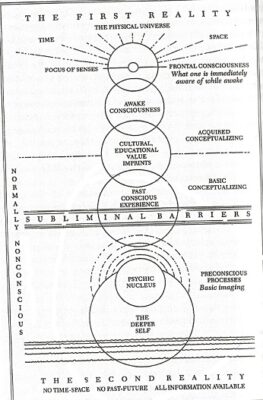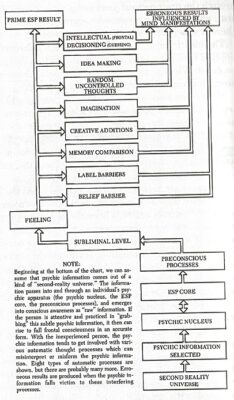
Source: Deposit Photos
An intriguing description of how intuition works comes from Ingo Swann’s explanation of ESP. Swann, along with Stanford physicist Harold Puthoff, developed the process for remote viewing that the U.S. military used. Swann, a remote viewer himself, did the teaching. In his book, Everybody’s Guide to Natural ESP, Swann says anyone can do remote viewing. Essentially it involves nonconscious information rising to consciousness. Here’s the gist of how he thought it works.
Subliminal Barrier Filters Information
Our “deeper self,” our subconscious, transcendent self, soul, or any variety of names for it, is connected to the energetic quantum information world underlying the physical universe—the “second reality” notation at the base of the diagram below from Swann’s book. That’s where the intuitive information comes from. So that we’re not flooded and overwhelmed, Swann says a subliminal barrier allows only select information to make it to our conscious, waking mind. Without that barrier, it would be like listening to 1,000 radio channels simultaneously. Usually we receive the information that’s most important to us.

Like the quantum world itself, which physicists are still trying to understand, intuition works by its own logic and processes. Those are represented in the diagram by the overlapping circles in the nonconscious space below the subliminal barrier. The deeper self’s qualities must operate similar to those of quantum reality, which facilitates the connection. Neither intuition nor the quantum world seems to be affected by time, space or the resistance of matter.
What’s Going On Below the Mind’s Surface?
So, what’s going on below the subliminal barrier? What are those preconscious processes? It’s murky. Nonconscious stimuli enter idea and creativity generating processes that interact with memory to take on a form that can be recognized by logic and analysis when it reaches conscious awareness. This subjective process cannot be willfully controlled. With practice, it can be recognized though and conducive environments can be set up to facilitate it. Artists and other creative professionals often use rituals, a favorite place, or some personalized means to bring on the muse. Swann thought ESP uses the same channels and similar processes.
Unlocking Natural Talents & Learning Discernment
Focusing attention and training awakens our waking consciousness to the deeper self’s workings. Even so, the nonconscious information we access can be diverted or misinterpreted by conceptualizing filters on its way to full frontal consciousness (shown in the upper portion of the diagram).
That’s what training helps with. In his book about working as a remote viewer for the military, Lyn Buchanan says Swann’s method doesn’t “teach someone to be psychic.” It “teaches them to get rid of all those blocks that prevent them from using the natural and hidden talents they already have. For most people, that is a surprising amount.” (p. 32). Like any talent though, some people are more naturally able to access subliminal information and bring it accurately to consciousness than others.

This diagram, also from Swann’s book, shows some of our basic and acquired conceptualizing filters that can keep our deeper self’s messages from getting to waking consciousness fully and accurately. The conscious mind uses these frameworks and strategies to process information. They may work well with information our normal sensory system brings in. But intuitive information is likely to be grasped whole; those sudden insights that don’t need interpretation. Their meaning is clear on arrival. If the info gets snared by these filters instead of reaching waking consciousness raw, it may come out partial or wrong. It’s possible though, if the conscious filters align with the intuitive content, the conscious message could be reasonably accurate.
For most of us, nonconscious information appears sporadically and spontaneously, often in bodily or emotional form or in dreams or daydreams. The sense that someone we love is in danger is a good example. We may not know the specifics, just the visceral sense or physical discomfort and who it’s associated with. How the deeper self initiates that spontaneous, non-conscious awareness that shoots directly to the surface remains a mystery, one even Swann didn’t understand.
